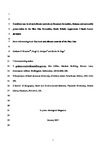Combined sea-level and climate controls on limestone formation, hiatuses and ammonite preservation in the Blue Lias Formation, South Britain (uppermost Triassic – Lower Jurassic)
| dc.contributor.author | WEEDON, GRAHAMP | |
| dc.contributor.author | JENKYNS, HUGHC | |
| dc.contributor.author | PAGE, KEVINN | |
| dc.date.accessioned | 2017-02-15T17:22:35Z | |
| dc.date.issued | 2017-01-30 | |
| dc.identifier.issn | 0016-7568 | |
| dc.identifier.issn | 1469-5081 | |
| dc.identifier.uri | http://hdl.handle.net/10026.1/8505 | |
| dc.description.abstract |
Lithostratigraphic and magnetic-susceptibility logs for four sections in the Blue Lias Formation are combined with a re-assessment of the ammonite biostratigraphy. A Shaw plot correlating the West Somerset coast with the Devon/Dorset coast at Lyme Regis, based on 63 common biohorizon picks, together with field evidence, demonstrate that intra-formational hiatuses are common. Compared to laminated shale deposition, the climate associated with light marl is interpreted as both drier and stormier. Storm-related non-deposition favoured initiation of limestone formation near the sediment–water interface. Areas and time intervals with reduced water depths had lower net accumulation rates and developed a greater proportion of limestone. Many homogeneous limestone beds have no ammonites preserved, whereas others contain abundant fossils. Non-deposition encouraged shallow sub-sea-floor cementation which, if occurring after aragonite dissolution, generated limestones lacking ammonites. Abundant ammonite preservation in limestones required both rapid burial by light marl during storms as well as later storm-related non-deposition and near-surface carbonate cementation that occurred prior to aragonite dissolution. The limestones are dominated by a mixture of early framework-supporting cement that minimized compaction of fossils, plus a later micrograde cement infill. At Lyme Regis, the relatively low net accumulation rate ensured that final cementation of the limestones took place at relatively shallow burial depths. On the West Somerset coast, however, much higher accumulation rates led to deeper burial before final limestone cementation. Consequently, the oxygen-isotope ratios of the limestones on the West Somerset coast, recording precipitation of the later diagenetic calcite at higher temperatures, are lower than those at Lyme Regis. | |
| dc.format.extent | 1-33 | |
| dc.language | en | |
| dc.language.iso | en | |
| dc.publisher | Cambridge University Press (CUP) | |
| dc.subject | sedimentary cycles | |
| dc.subject | sea level | |
| dc.subject | climatic cycles | |
| dc.subject | Blue Lias Formation | |
| dc.subject | diagenesis | |
| dc.subject | hiatuses | |
| dc.title | Combined sea-level and climate controls on limestone formation, hiatuses and ammonite preservation in the Blue Lias Formation, South Britain (uppermost Triassic – Lower Jurassic) | |
| dc.type | journal-article | |
| dc.type | Journal Article | |
| plymouth.author-url | https://www.webofscience.com/api/gateway?GWVersion=2&SrcApp=PARTNER_APP&SrcAuth=LinksAMR&KeyUT=WOS:000434422300007&DestLinkType=FullRecord&DestApp=ALL_WOS&UsrCustomerID=11bb513d99f797142bcfeffcc58ea008 | |
| plymouth.issue | 5 | |
| plymouth.volume | 155 | |
| plymouth.publication-status | Published online | |
| plymouth.journal | Geological Magazine | |
| dc.identifier.doi | 10.1017/S001675681600128X | |
| plymouth.organisational-group | /Plymouth | |
| plymouth.organisational-group | /Plymouth/Faculty of Science and Engineering | |
| plymouth.organisational-group | /Plymouth/REF 2021 Researchers by UoA | |
| plymouth.organisational-group | /Plymouth/REF 2021 Researchers by UoA/UoA07 Earth Systems and Environmental Sciences | |
| dcterms.dateAccepted | 2016-12-12 | |
| dc.rights.embargodate | 2017-7-30 | |
| dc.identifier.eissn | 1469-5081 | |
| dc.rights.embargoperiod | Not known | |
| rioxxterms.versionofrecord | 10.1017/S001675681600128X | |
| rioxxterms.licenseref.uri | http://www.rioxx.net/licenses/all-rights-reserved | |
| rioxxterms.licenseref.startdate | 2017-01-30 | |
| rioxxterms.type | Journal Article/Review |


